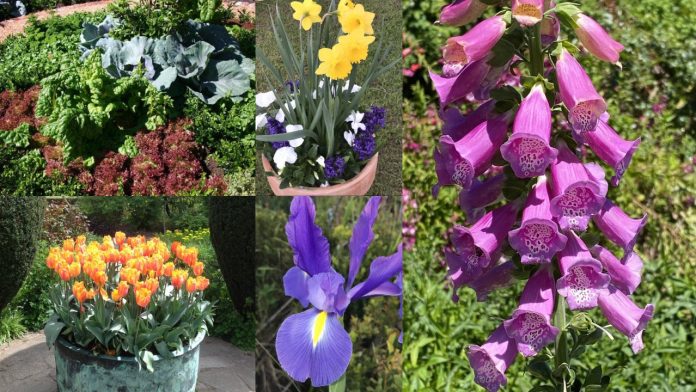After summer, the cooler days of autumn beckon us to get back outside in the garden and tackle those jobs that we put off due to the oppressive heat and sizzling summer sun. The early morning moist dew of autumn provides welcome relief for our gardens to rejuvenate from the stresses of heat and drought. So, autumn is the perfect time to give your garden a revamp or refresh, ready for the cooler weather.
My To-Do List of autumn garden tasks are:
Lawns
• Aerate compacted dry patches or worn-out areas of lawn with a garden fork or lawn aerator.
• Rake over worn or dead patches of grass to remove any dead material or thatch. Use a lawn or spring-tine rake for the best results.
• Mow your lawn at least every one to two weeks to encourage it to spread and cover up any bare patches before winter.
• Apply a wetting agent to allow deeper water penetration, reduce the run-off of water and improve water repellent soils or ‘dry patch’ in lawns.
• Feed your lawn now with a slow or controlled release lawn food to help thicken up your lawn and encourage it to spread, so it is less susceptible to weed infestation.
• Rake up and compost any fallen leaves that cover the grass and may cause diseased or dead areas.
• If winter grass has been a problem in previous years, use a pre-emergent herbicide from late April onwards until the end of May, for the most effective control. A follow-up spray for severe cases may be required before the end of June. Amgrow, David Grays and Munns all produce effective winter grass killers. Always wash it into the soil thoroughly after application to produce an effective barrier to seed germination.
Vegetable Patch
• Early autumn is the time to sow brassicas including broccoli, Brussels sprouts, cabbage, cauliflower, kale and Asian greens such as pak choi, bok choi, tatsoi, mizuna, Chinese cabbage and mustard greens. Asian greens are best sown in the garden bed where they are to grow. Sow slower growing brassicas in seed trays or punnets before planting out in the garden later.
• Autumn is caterpillar season so keep an eye out for cabbage white butterfly, cabbage moth and looper caterpillars on your vegies. They will attack both young plants or mature brassica plants, so use an organic based spray such as Dipel, Success Ultra, or the Beat A Bug Naturally Based Insect Spray.
• The cooler weather makes it much easier to grow your fresh leafy greens for salads. Use any spare space in the garden or reasonably sized pots or containers will provide sufficient produce for a family. Some of the best ‘cut and come again’ varieties of lettuce include: Baby Butterhead, Cos, Frizmo, Green Mignonette, Iceberg, Oakleaf, Revolution and Salad Bowl.
• Snails and slugs become more prevalent with the cooler and moister weather. Patrol with a torch patrol during the early evening to catch any chomping on your tasty vegies. Iron chelate pellets and beer traps work well in my veggie patch. A copper-based spray used around and under the edges of raised planters also works.
Fruit
• If your fruit trees were reluctant to flower and fruit this year, try using a high potash fertiliser to encourage flower and fruit formation for next spring. I use potassium sulphate in a watering can every two weeks until the end of May.
• Citrus leaf miner will affect the soft new growth on citrus, so spray with Eco Oil and bait with the eco-CLM trap to catch the male adults.
• Continue feeding your watermelons, rockmelons, zucchinis, cucumber and pumpkins with a high potash fertiliser. Avoid watering over the leaves to deter mildew, which can affect their overall vigour.
Garden
• Check out your local garden centre for some of the latest new plant varieties. You may find the perfect plant to fill that bare space in the garden.
• Lightly trim shrubs and hedges to encourage dense growth before applying a wetting agent and an organic fertiliser.
• Trim and deadhead your roses in mid-March, then apply a liquid fertiliser to promote a final flush of blooms in May.
• Mulch your garden beds and soil with manure, compost, mushroom compost, lupin mulch or pea straw before winter to improve the soil. Remember to weed the garden first.
Flower Garden
• From St Patrick’s Day (17 March) onwards it is the time to sow your sweet peas. I use 130mm pots filled up to three quarters full, with potting mix, then water them well. After allowing them to drain, I place six to eight seeds evenly around the pot. Next, cover the seeds with seed raising mix and do not water until the seeds germinate in 14–21 days.
• Sow poppy and foxglove seeds directly in the garden where they are to grow. Add some compost or soil improver first and rake to a firm fine tilth. Moisten the surface before scattering the seed finely over the surface and gently water them in. Do not cover the seed.
• Autumn is bulb planting time, so try filling any bare spots in your garden with easy-to-grow naturalising bulbs such as freesia, jonquils, Dutch iris, ixia, sparaxis and snowflakes. You can also plant up some colourful pots or containers with tulips, anemone, hyacinths, ranunculus and jonquils or daffodils.
• Vibrant autumn and winter flowers will now be in your local nursery and garden centres, so look out for alyssum, calendula, cineraria, dianthus, English daisies, forget-me-nots, lobelia, pansies, poppies, primulas and violas. They are perfect for pots, containers, hanging baskets or as fillers in the garden. You can mix, interweave and contrast them with bulbs for a sensational effect.
Garden Festival back in Perth
Western Australian premier gardening event has been expanded and is now the Perth Garden and Outdoor Living Festival. The revamped event takes place next month from Thursday 29 April to Sunday 2 May at the new location of Langley Park in Perth.
Go to www.perthgardenfestival.com for more information and updates.






































